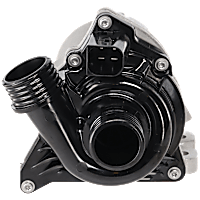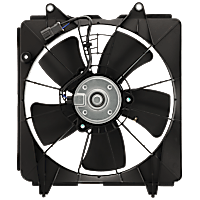The engine must operate within a certain temperature range to ensure optimum efficiency and prevent overheating. A P2181 code is logged when engine temperatures read unusually high or low.
What Does the P2181 Code Mean?
Diagnostic trouble code (DTC) P2181 stands for “Cooling System Performance.” It is triggered when the powertrain control module (PCM) detects that the coolant temperature in the radiator and engine is outside of the normal range (too hot or too cold).
This code is similar to a P0128 or P0125 code but can also indicate engine overheating or electrical problems with the sensor circuit.
Unlike other DTCs that point to specific components that might be malfunctioning, this powertrain code is generic and does not include any specifics. Therefore, it is important to check for other codes that may have been logged by onboard diagnostics.

What are the Possible Causes of the P2181 Code?
The 2019 Chrysler 300 Diagnostic routine lists these possible causes:
- Low coolant level
- Thermostat
- ECT signal circuit shorted to voltage
- ECT signal circuit shorted to ground
- ECT signal circuit shorted to the sensor ground circuit
- ECT signal circuit open or high resistance
- Sensor ground circuit open or high resistance
- Engine coolant temperature (ECT) sensor
- Powertrain control module (PCM)
Possible causes on other platforms might be as follows:
- Defective or malfunctioning engine coolant temperature sensor
- Low engine coolant level due to a leak
- Failing thermostat (stuck open or closed)
- Engine overheating due to a faulty water pump, failed cooling fan, etc.

What are the Common Symptoms of the P2181 Code?
Here are two of the most common symptoms of code P2181:
Extremely high or low readings on the engine temperature gauge / temperature warning light is on
This DTC may cause a vehicle’s engine temperature gauge to read abnormally high or low temperatures. Vehicle models without an engine temperature gauge may trigger a temperature warning light on the dashboard, instead.
Engine running cold
A thermostat that is stuck open will allow coolant to flow nonstop from the engine into the radiator. This can result in the engine running cold, preventing it from reaching the optimal operating temperature. A cold engine will have a rich air-to-fuel mix that causes poor fuel economy.
At the same time, this problem may also have a negative impact on the ability of your heater to warm up the vehicle cabin.

Engine overheating
The most common symptom of a cooling performance issue is engine overheating. This is typically caused by a thermostat that is stuck closed or a leak that prevents sufficient coolant from flowing through the engine. Of course, there are other potential causes, as well, such as a faulty water pump or a malfunctioning cooling fan.
If the cooling fan isn’t working properly, cooling system performance code 2181 may also prevent your A/C system from cooling down the vehicle cabin.
The impact of an engine running cold pales in comparison to the catastrophic effects of an overheating one, which can cause extensive engine damage.
How to Diagnose the P2181 Code
Some vehicle cooling systems have parts that are easily serviceable, while other designs are less accessible and require professional know-how. Check out this video about the P2181 code on a VW to get an idea of what the diagnostic process might involve:
How to Fix the P2181 Code
The steps for diagnosis and repair for code P2181 may vary between different makes and models. Given that the P2181 code is less specific than other trouble codes, it may be wiser to go to an auto repair shop and have your vehicle checked by a professional to rule out any underlying issues.
If you are keen on fixing this code on your own, vehicle repair manuals, such as those from Chilton, could be a useful resource. Better yet, you may get vehicle-specific factory repair information through an ALLDATA subscription.
Products Mentioned in this Guide
Any information provided on this Website is for informational purposes only and is not intended to replace consultation with a professional mechanic. The accuracy and timeliness of the information may change from the time of publication.



 Coolant Temperature Sensor
Coolant Temperature Sensor
 Thermostat
Thermostat
 Water Pump
Water Pump
 Cooling Fan Assembly
Cooling Fan Assembly















